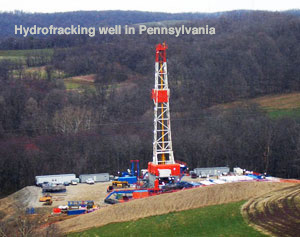
During hydrofracking, the drill bit begins to bore vertically but then is turned horizontally to cut through the fractures

FRONT PAGE
Site Search
About us



Hydrofracking: Risks & regulations
Urban energy saving (USA)
Gas drilling in eastern US cities
US cities fight back
Environmental effects of US wine production
Greenest US cities
Great Lakes initiative
Pros and cons of biofuels
Green schools
Los Angeles goes green

Worldwide | Elections | North America | Latin America | Europe | Asia | Africa |


























US mayors demand stronger
regulations on hydrofracking
By Tony Favro, USA Editor*
21 February 2012: In December 2011, Mayor Matt Ryan of Binghamton, New York, signed into law a two-year ban on hydrofracking in his city. Mayor Ryan had concerns about the natural gas drilling technique because of “regulation as it now stands”. Three hundred kilometers away, Mayor Michael Bloomberg voiced his opinion that hydrofracking poses “unacceptable risks” to the water supply of New York City. Regulation, of course, is a way of balancing risks and benefits. Hydrofracking seemed questionable on a large scale in the United States just six months ago, but now it appears inevitable, and the focus of the debate has turned to risk management.
Demand and regulation
Three months ago, the US Environmental Protection Agency issued strict new carbon emission standards for coal-fired electric generating plants. Unless the regulations are overturned by the courts (and lawsuits are pending), coal production will become more expensive and therefore less-competitive with natural gas. In his January State of the Union address, President Obama highlighted hydrofracking as an example of the promise of a clean energy future for the US, noting that it now accounts for a third of US natural gas production.
Today, the supply of natural gas exceeds demand, which means that it costs more to blast a mix of water, sand, and chemicals into shale rock thousands of feet into the ground than the market price of the natural gas that is extracted. The new EPA regulations are expected to result in price increases for natural gas. This signals the inevitability of hydrofracking to many mayors and also, as former Mayor Calvin Tillman of Dish, Texas says, the need for “tighter regulations and more transparency in the drilling process”.
 Risks
Risks
Dish, Texas has hundreds of hydrofracked wells and was the site of the documentary film Gasland with the memorable scene of a homeowner igniting his natural-gas-infiltrated tap water. The city, under Mayor Tillman, also commissioned several independent studies, which contradicted industry and state of Texas claims that hydrofracking was not a threat to groundwater supplies, air quality, and human health. The independent studies showed higher levels of contamination than the state and gas industry disclosed and helped fuel a national debate over the merits of hydrofracking.
Dish is a small city, and it is the small, rural communities that stand to incur most of the risks because that is where almost all hydrofracking takes place.
For example, hydrofracking a single, average-size well can generate 40,000 or more trips by heavy trucks. Though the well operator may be contractually required to repair roads it damaged, proving liability can be difficult. Was the road properly constructed to begin with? Was it already old and deteriorated before drilling began? Well operators have used these arguments and others in Pennsylvania and West Virginia to avoid liability, leaving small municipalities vulnerable to enormous road repair expenses or enormous legal expenses to sue the well operator for breach of contract. Similar scenarios have played out for individual homeowners. Were their drinking water wells contaminated by chemicals used in nearby hydrofracking or by naturally-occurring selenium and arsenic? The burden of proof, including the expense, is on the homeowner.
Risk management
President Obama offered 20 recommendations for reducing the risks of hydrofracking to individuals and communities in his State of the Union address. The recommendations include requiring gas producers to disclose the chemicals they use in the hydrofracking process and closer monitoring of each well with data posted on the Internet. The President’s recommendations apply to hydrofracking on federal lands. It will be up to the states to apply them on state and local property where most hydrofracking occurs, and to include both small and large gas producers.
With adequate regulations, hydrofracking could increase natural gas supplies, provide a higher level of energy security, create jobs, and reduce greenhouse gas emissions in the US. The future of hydrofracking, however, is cloudy. The hydrofracking industry is highly speculative, with costs currently exceeding returns by three to one; long-term costs are more difficult to assess since the gas reserves that are easiest and cheapest to extract will be depleted first; the natural gas distribution system must be bolstered with new pipelines and shipment facilities before full benefits can be achieved; lawsuits are in progress, and therefore regulatory mechanisms are uncertain; and public acceptance in not a sure thing.
The future of American cities on or near shale deposits likely will intersect with the future of hydrofracking. Mayors are in a pivotal role. As mayor Luke Ravenstahl of Pittsburgh says, “city leaders should take a leadership position when it comes to making decisions on energy and energy efficiency”.
*Tony Favro also maintains the blog Planning and Investing in Cities.
Comment on this article
Read comments
Follow @City_Mayors

